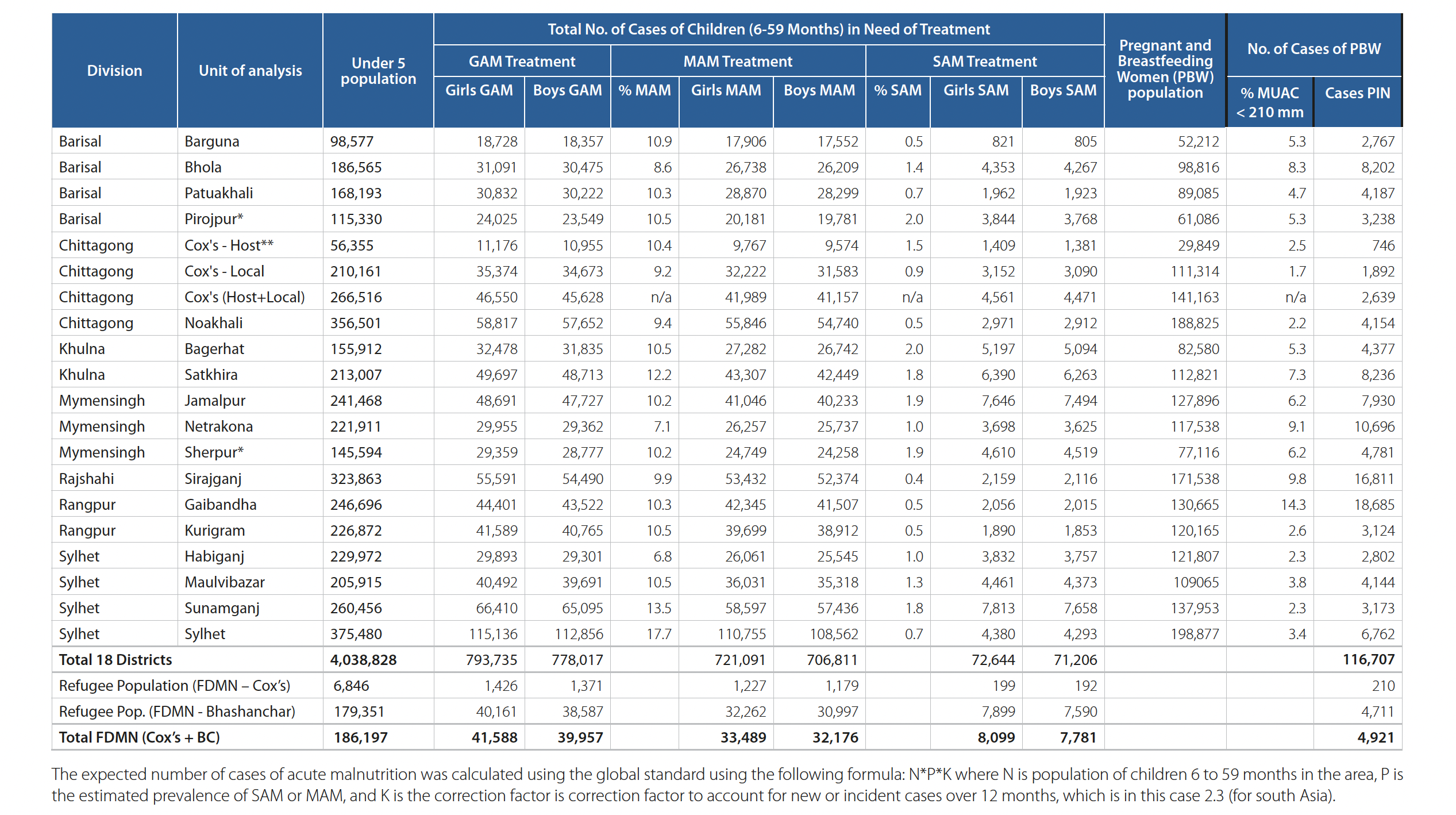04.07.2025
01.01.2025 > 31.12.2025
Map
Projected Map
Other Projections



Key
results
Population
estimates
Recommendations
& next steps
Acute
Malnutrition
Bangladesh's first IPC Acute Malnutrition (AMN) analysis finds that approximately 1.6 million children aged 6 to 59 months are suffering or expected to suffer acute malnutrition between January and December 2025, including 143,850 children facing Severe Acute Malnutrition (SAM). Around 117,000 pregnant or breastfeeding women (PBW) are suffering or expected to suffer acute malnutrition in the same period. The districts most affected are Bhola, Cox’s Bazar, Bagerhat, Sirajganj, Gaibandha, Kurigram and Bhashanchar where food insecurity is more prevalent.
Multiple underlying and contributing factors continue to affect the nutritional status of children under the age of five, as well as PBW, and other vulnerable populations including displaced people and their host communities. These include inadequate food intake, alarmingly low lack of dietary diversity, childhood illnesses (endemic diarrhoea, acute watery, childhood fever), and poor WASH conditions. Acute food insecurity also limits access to nutritious foods, while recurrent shocks, such as floods and cyclones, have disrupted essential health, nutrition, and WASH services, deepening household vulnerability.
The first AMN analysis in Bangladesh covered 18 districts across seven divisions, as well as the Rohingya refugee populations in Cox’s Bazar and Bhashanchar camps. For the current period of analysis (January-April, 2025) 11 districts were classified in IPC AMN Phase 3 (Serious), and seven districts were classified in IPC AMN Phase 2 (Alert). Among the refugee population, Cox’s Bazar was classified in IPC AMN Phase 3 and Bhashanchar in IPC AMN Phase 2. For the projected period (May–December 2025), five districts currently in IPC AMN Phase 2 are projected to shift to IPC AMN Phase 3, while the majority of areas in IPC AMN Phase 3 are expected to experience a deterioration in the nutritional status of children and PBW.
Country Related Information
Contacts
- 01.04.2025 > 31.12.2025
Bangladesh: Acute Food Insecurity Current Situation for April and Projection for May - December 2025 - 01.10.2024 > 31.12.2024
Bangladesh: Acute Food Insecurity Projection Update October - December 2024 - 01.02.2024 > 31.10.2024
Bangladesh: Acute Food Insecurity Situation for February - March 2024 and Projection for April - October 2024 - 01.03.2023 > 30.09.2023
Bangladesh: Acute Food Insecurity Situation for March - April 2023 and Projection for May - September 2023 - 01.12.2019 > 30.11.2024
Bangladesh: Chronic Food Insecurity Situation 2019-2024 - 01.06.2016 > 30.04.2017
Bangladesh: Acute Food Insecurity Situation for June-November 2016 and Projection for January-April 2017 - 01.12.2015 > 31.12.2020
Bangladesh: Chronic Food Insecurity Situation 2015-2020 - 01.09.2014 > 31.12.2014
Bangladesh: Acute Food Insecurity Situation September - December 2014 - 01.08.2013 > 31.10.2013
Bangladesh: Acute Food Insecurity Situation August - October 2013 - 01.12.2012 > 31.12.2012
Bangladesh: Acute Food Insecurity Situation in December 2012 (Coastal Zones)
- 19.04.2025 > 23.04.2025
Bangladesh: Acute Food Insecurity and Acute Malnutrition Analyses - 05.02.2024 > 12.02.2024
Bangladesh: Acute Food Insecurity - 15.03.2023 > 20.03.2023
Bangladesh: Acute Food Insecurity Analysis - 03.11.2019 > 08.11.2019
Bangladesh: Chronic Food Insecurity Analysis
Join our mailing list


